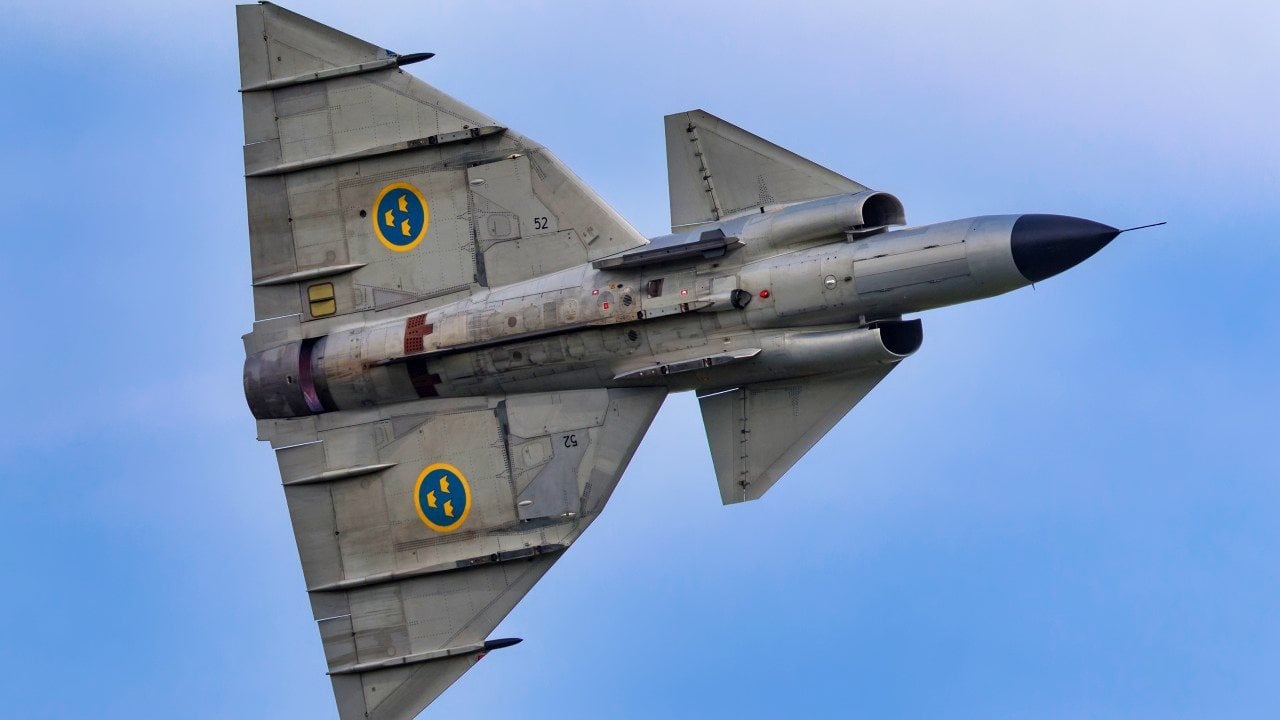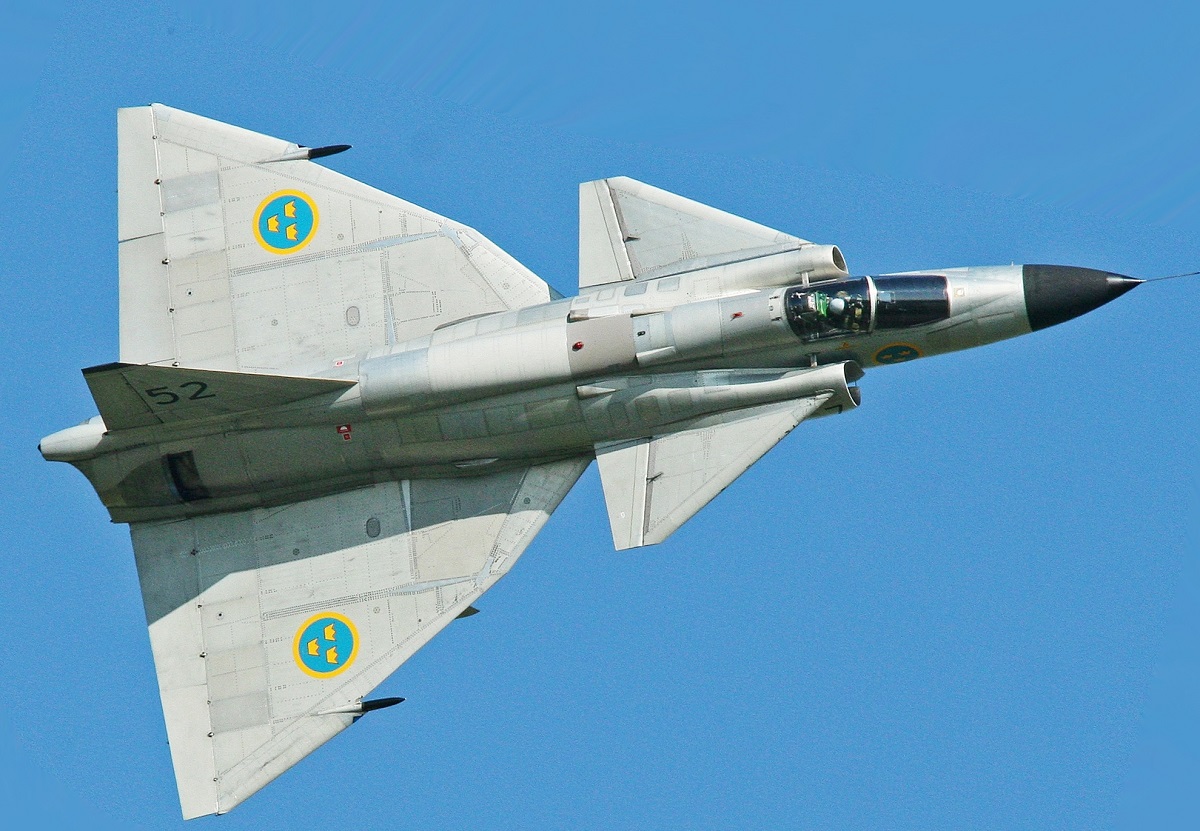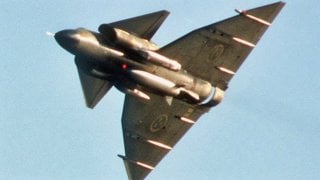Saab-37 Viggen: The Best Fighter Jet You Never Heard Of Until Now
Known for its versatility, the Saab-37 Viggen could carry a range of munitions, from missiles to bombs. It boasted advanced avionics, including the Ericsson PS-37/A radar and Saab CK 37 central computer, enhancing its combat capabilities.
Summary and Key Points: The Saab-37 Viggen, a fourth-generation Swedish-built fighter jet, was the backbone of the Swedish Air Force from the 1970s to 2007.

-Known for its versatility, the Viggen could carry a range of munitions, from missiles to bombs. It boasted advanced avionics, including the Ericsson PS-37/A radar and Saab CK 37 central computer, enhancing its combat capabilities.
-Equipped with defensive systems like radar warning receivers and electronic countermeasures, the Viggen was a formidable adversary. Its impressive speed, range, and robust armament made it an iconic warplane during the Cold War.
Saab-37 Viggen: Sweden's Cold War Thunderbolt Jet
The Saab-37 Viggen (“Thunderbolt”) was a Swedish-built fighter jet of the fourth-generation of warplanes. Built in the 1970s, it was primarily used by the Swedish Air Force. A total of 329 Viggen warplanes were built. It was a single-seat, single-engine fighter-bomber that became the backbone of the Swedish Air Force.
A versatile warbird, that was capable of carrying a variety of weapons, from missiles to bombs all the way to a 30mm cannon, this Saab-built plane became an icon of Swedish engineering during the latter half of the Cold War (in which a hulking Soviet Union pressed hard against the Nordic nations of Europe).
Finland and Austria had some units in their respective air forces as well.
Sweden’s Saab-37 Viggen had a fuel range of around 2,000 kilometers (1,242.74 miles). This bird had an impressive cruising speed of Mach 1.7 (or 1,300 miles per hour), with an operational ceiling of around 60,000 feet.
According to my colleague, Stavros Altamazoglou writing in these pages, a Saab-37 is rumored to have caught up to speeding SR-71 Blackbirds, that routinely overflew Swedish territory on their way to surveil Soviet territory (Sweden was a neutral country in the Cold War).
Defensive Systems
Viggen warplanes were equipped with a variety of defensive systems to ensure its survival in combat. These defensive capabilities included Radar Warning Receivers (RWR) which were used to detect and identify radar emissions from enemy aircraft and ground-based radar systems. Pilots of the Saab-37, using the RWR, could take immediate evasive action or engage the enemy based on the sophisticated (for the era) telemetry that the RWR provided pilots.
Other defensive systems included chaff and flare dispensers. The Viggen deployed these defensive countermeasures to confuse and distract enemy radar and infrared-guided missiles.
For the uninitiated, chaff is a cloud of small, thin pieces of aluminum or plastic that reflects radar waves of the kind that are emitted by missiles honing into a targeted aircraft. Flares, on the other hand, are small, bright heat sources that can confuse incoming heat-seeking missiles, making their rudimentary heat-seeking capabilities lock onto the flare’s heat source rather than the heat generated by the warplane’s engines.
The bird had an electronic countermeasure (ECM) suite as well. The ECM system is designed to jam and disrupt enemy radar and communications systems. This could be used in combat to degrade the enemy’s situational awareness of prevent the targeting of the Saab-37 by enemy systems.
Another unique design feature for the Saab-37 was self-sealing fuel tanks.
In other words, the Saab-37’s fuel tanks were very difficult to compromise by enemy firepower. When in combat, if the fuel tanks were punctured in some way, the Saab-37’s fuel tanks automatically seal the hole to prevent fuel from leeching out (without which the survivability of the Saab-37 would be greatly reduced).
In terms of armor, the Viggen’s cockpit and critical systems were heavily protected by armor plating. This was an essential element because it protected the pilot and flight controls in the event of a direct hit while in combat.
Avionics Package Equals Greater Versatility
One of the reasons that the Saab-37 Viggen was such a versatile and respected warplane during its existence was the bird’s advanced avionics package. This included an Ericsson PS-37/A radar, which used an X-band monopulse for air-to-air and air-to-surface target detection and tracking.
A central computer known as the Saab CK 37 was integrated into the aircraft’s avionics systems and provided data processing and management capabilities. This was a byproduct of the Fourth-Generation warplane, what with this generation coming out around the time that significant advances in computer technologies were also occurring.
The Saab-37 employed a Decca Type 72 Doppler navigation radar. With this technology, the Viggen was provided with accurate navigation information, which allowed for the pilot to navigate with even more precision than they would have had in another bird. Things like ground speed and drift angle were included in the Type 72 Doppler navigational radar array.
Things like air speed, altitude, angle of attack, and other critical information related to onboard avionics systems were relayed to the pilot in-flight by a digital Central Air Data Computer.
Again, this is something that today is taken for granted by modern pilots. Back in the 1970s, when the Saab-37 was first deployed, these were novelties.
The pilot was given a Heads-Up Display (HUD) that displayed critical flight and navigational information directly into the pilot’s line-of-sight. With the HUD, the pilot was able to keep their eyes on the outside world speeding around the cockpit while still monitoring important flight information.
A sophisticated weapons management system was included in the warbird. It allowed for the pilot to select, arm, and release a variety of the bird’s air-to-air and air-to-surface munitions. So, the pilot of the Viggen was not only provided with state-of-the-art situational awareness but they were given the ability to engage enemies quicker and more efficiently than the pilots of other birds could—given the Saab-37 advantages.
Armaments on Saab-37
Speaking of armaments, the munitions package for the Saab-37 included the AIM-9 Sidewinder air-to-air missile, the AIM-120 AMRAAM, and the Swedish-made Rb-24, Rb-27, and Rb-28 missiles. In terms of air-to-surface missiles, the Viggen could carry the AGM-65 Maverick, the Rb-04 and Rb-05 anti-ship missiles, and the Rb-75 and Rb-71 air-to-ground missiles.
This bird carried 70mm and 135mm unguided rockets.
The Saab-37 brought with it an assortment of bombs, including the Mk-82, Mk-83, and Mk-84 bombs as well as cluster bombs and anti-runway bombs.
An Awesome Warbird
When laypeople think of great fourth-generation warplanes, they usually don’t envision the Saab-37. But they should. The Saab-37 is an impressive platform that formed the backbone of the Swedish Air Force.
Had the Soviets invaded Europe at any time during the plane’s service, the Saab-37 might have been at the frontlines of any defense of Europe. And they would have faced a truly formidable plane. At the very least, because of Sweden’s neutrality in the Cold War, these birds would have prevented either NATO planes or Soviet planes from crossing Swedish airspace.

Sweden ultimately retired the final Saab-37 from active duty in 2007.
Author Experience and Expertise: Brandon J. Weichert
Brandon J. Weichert, a National Interest national security analyst, is a former Congressional staffer and geopolitical analyst who is a contributor at The Washington Times, the Asia Times, and The-Pipeline. He is the author of Winning Space: How America Remains a Superpower, Biohacked: China’s Race to Control Life, and The Shadow War: Iran’s Quest for Supremacy. His next book, A Disaster of Our Own Making: How the West Lost Ukraine, is due October 22 from Encounter Books. Weichert can be followed via Twitter @WeTheBrandon.
All images are Creative Commons or Shutterstock.
From the Vault
Russia Freaked Out: Why the U.S. Navy 'Unretired' the Iowa-Class Battleships
Battleship vs. Battlecruiser: Iowa-Class vs. Russia's Kirov-Class (Who Wins?)


